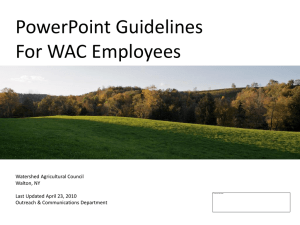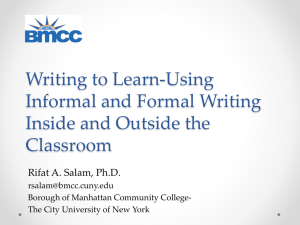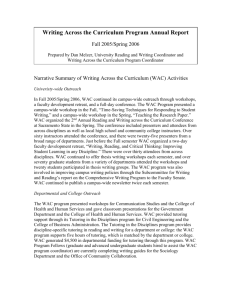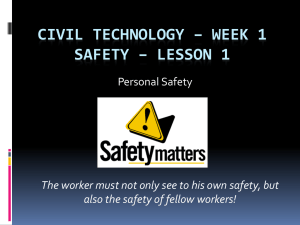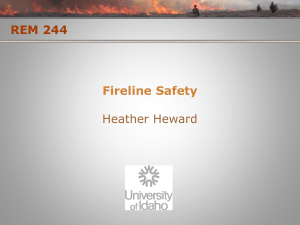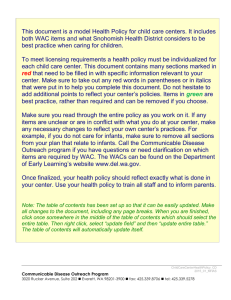PCFCA_Mtg_Mins_2013-03-07 pwrpt WAC 296
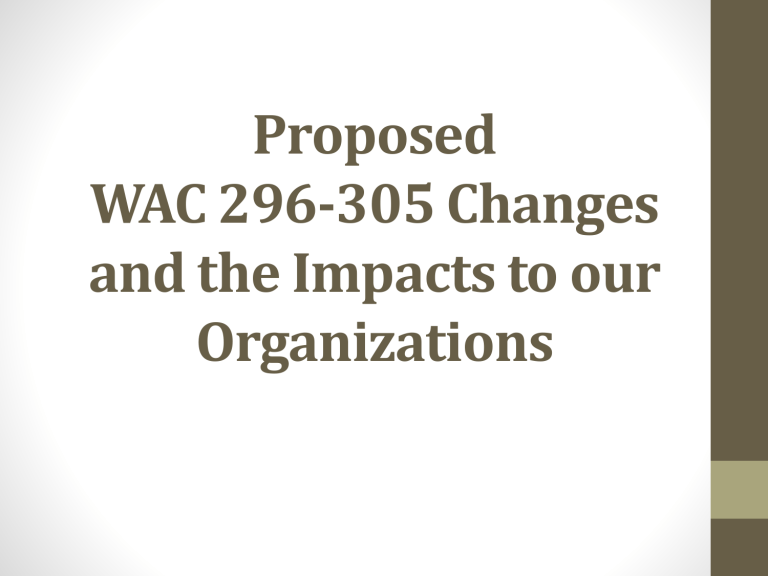
Proposed
WAC 296-305 Changes and the Impacts to our
Organizations
Committee’s Charge:
• Review the Revised Standard
• Identify the Impacts
• Develop an Implementation Plan
Caveat Emptor
• Our presentation/recommendations do not usurp YOUR authority/responsibility to know the
Vertical Standards.
Automotive Fire Apparatus Design and
Construction WAC 296-305-04501
Amended Section!
Impact? Yes
• All Hoses and Equipment must be secured
• ERG can be digital
• Wheel Chocks must be rated for apparatus they are used with if GVW>20,000 lbs
• Recommend Policy and practice of securing all equipment
Fire Service Equipment
WAC 296-305-06001
Amended Section!
Impact? No
• However, using a cutting blade on a Stihl circular saw voids their warranty. Must use abrasive blades only.
Fire Department Facilities
WAC 296-305-06503
Amended Section!
Impact? No
• Will need to comply with new regulations when constructing a new station or adding onto an existing station.
• Recommend reading if you are planning on building a new facility.
Personal Protective Equipment and
Protective Clothing WAC 296-305-02001
Amended Section!
Impact? Yes
• If the fire department does its own cleaning, they shall follow the manufacturer's recommended cleaning procedure or the 2008 edition of NFPA 1851, Standard on Selection,
Care and Maintenance of Protective Ensembles for Structural Fire Fighting and Proximity Fire
Fighting.
Personal Protective Equipment and Protective
Clothing WAC 296-305-02001
Continued
• Station/work uniforms if provided, shall meet the requirements as specified in the 1990 or 1994 edition of NFPA 1975, Standard on Station/Work
Uniforms for Fire and Emergency Services. However, departments are not required to provide station/work uniforms for their employees.
Personal Protective Equipment and
Protective Clothing WAC 296-305-02001
• The fire department shall inform members of the hazards of fabrics that melt, drip, burn, stick to the skin and cause burns to the wearer due to poor thermal stability or poor flame resistance, and shall prohibit their use by employees.
Garments that are not provided by the employer, and that are made from all or mostly cotton, will meet the requirements of this section.
Structural Firefighting Clothing
WAC 296-305-02002
New Section
Impact? No
(1) All SFF clothing purchased after January 1,
2012, shall meet the requirements of the 1991 edition of NFPA 1971, Standard on Protective
Clothing for Structural Fire Fighting, or the 1997 edition of NFPA 1971, Standard on Protective
Ensemble for Structural Fire Fighting. Firefighters shall not wear personal protective clothing manufactured prior to 1991, except for training purposes in nonhazardous areas.
Structural Firefighting Clothing
WAC 296-305-02002
Continued
• SFF clothing shall be maintained as specified by the manufacturer.
• Repairs to SFF clothing shall be done to the manufacturer's specification by qualified individuals approved by the manufacturer.
Repairs must be made using materials and methods in accordance with the applicable standards under which the article was produced.
Repairs include any and all alterations, modifications, additions, deletions or any other change made to the manufacturer's PPE article.
Structural Firefighting Clothing
WAC 296-305-02002
• SFF clothing which is damaged or doesn't comply with this section shall not be used.
• All SFF clothing shall be inspected semiannually by an individual qualified by the employer.
Inspection intervals shall not exceed six months.
Body Armor
WAC 296-305-02012
New Section!
Impact? Yes
• Fire departments that use protective body armor shall comply with the following:
• If the employer's PPE assessment required by WAC 296-
800-16005 documents a need for body armor, the employer must provide the necessary equipment and ensure that:
(a) The body armor fits properly;
(b) Employees are trained in the use and limitation of the body armor
(c) The body armor is worn when necessary.
Body Armor
WAC 296-305-02012
Continued
• The fire department shall develop and have in place written guidelines for the care, use and maintenance of the protective body armor in conjunction with the manufacturer's recommendations.
Life Safety Ropes, Harnesses, and
Hardware Protection
WAC 296-305-02019
Amended Section!
Impact? No
• Life Safety Rope((, Harness, and Hardware, 1990 edition)) and System Components. Ropes and equipment purchased after the effective date of this rule must meet the 2006 edition of NFPA 1983,
Standard on Life Safety Rope and Equipment for
Emergency Services.
Respiratory Equipment Protection
WAC 296-305-04001
Amended Section!
Impact? Yes
• Firefighter's self-contained breathing apparatus
(SCBA) shall at a minimum, meet the requirements of the 1997 edition of NFPA 1981,
Standard on Open-Circuit Self-Contained
Breathing Apparatus for Fire Fighters.
Equipment purchased after the effective date of this rule must meet the 2007 edition of NFPA
1981, Standard on Open-Circuit Self-Contained
Breathing Apparatus for Emergency Services .
Respiratory Equipment Protection
WAC 296-305-04001
Continued
• They shall maintain documentation certifying breathing air quality.
• The breathing air shall: Be tested at least quarterly by using an air sample taken from the same outlet and in the same manner as the respirator breathing air cylinders are filled or air line respirators are connected.
Respiratory Equipment Protection
WAC 296-305-04001
Continued
• Meet the requirements of either the 2003 edition of NFPA 1989, Standard on Breathing Air Quality for
Fire and Emergency Services Respiratory Protection or the 1997 edition of ANSI/CGA G6-1 - Commodity
Specification for Air, with a minimum air quality of grade D.
• Meet a water vapor level of 24 ppm or less.
Respiratory Equipment Protection
WAC 296-305-04001
Continued
• Gross/field decontamination shall be performed on firefighters prior to removal of their respirator whenever firefighting activities resulted in exposure to a hazardous substance.
Emergency Medical Protection
WAC 296-305-02501
Amended Section!
Impact? NO
• Firefighters who perform emergency medical care or otherwise may be exposed to blood or other body fluids shall be provided with emergency medical face protection devices, and emergency medical garments that meet the applicable requirements of ((NAPA)) the
1999 edition of NFPA 1999, Standard on Protective
Clothing for Emergency Medical Operations ((1999, 1992 edition)).
Emergency Medical Protection
WAC 296-305-02501
Continued
• Employee tuberculosis screening shall be provided in accordance with current U.S. Centers for Disease
Control and Epidemiology guidelines.
Hazardous Materials
WAC 296-305-03002
New Section!
Impact? No
• Firefighters assigned to functional support operations outside the hot zone during hazardous chemical emergencies shall be provided with and shall use personal protective garments appropriate for the type of potential chemical hazard exposure.
Personal Alert Safety System (PASS)
Protection WAC 296-305-02017
Amended Section!
Impact? No
(1) Each firefighter ((working in a hazardous area)) engaged in structural firefighting requiring the use of SCBA shall wear and use a PASS device. PASS devices shall meet the requirements of the 1993 edition of NFPA 1982, Standard on Personal Alert
Safety Systems (PASS) for Firefighters
Personal Alert Safety System (PASS)
Protection WAC 296-305-02017
Continued
Amended Section!
Impact? No
Note: Fire departments should provide one spare
PASS device for each ten units in service. If a department has less than ten devices they should have one spare.
Incident Management
WAC 296-305-05000
Incident Management
New Section!
Impact? Yes
The Fire Department shall Establish and IMS consistent with NIMS.
At all emergency incidents, the IC shall be responsible for the Safety.
All Emergency incidents shall be managed by ICS.
At all emergency incidents the IC shall have the responsibility to: a) Assume and confirm command and take an effective fixed position.
b) Perform situational evaluation that includes risk management c) Initiate, maintain, and control incident communications.
d) Develop Strategy and IAP.
e) Develop an effective ICS Org.
f) Review, evaluate, and revise the IAP g) Continue, transfer, and terminate command.
Incident Management
Continued
The Fire department shall develop a risk management plan.
The fire department shall establish an accountability system.
The IC shall provide for control of access to hazardous areas of the incident scene. Procedures shall identify methods for identification of hazardous areas and communication of necessary protective equipment and other protective measures necessary to operate in the hazardous area.
a) Control zones shall be established at emergency incidents.
b) The perimeters of the control zones shall be designated by the IC and communicated.
c) If the perimeters of the control zones change during the course of the incident, you must communicate to all members.
d) Hazard control zones shall be designated Hot, Warm, Cold, exclusion zones.
Hazard Control Zones
Cold zone: The control zone of an incident that contains the command post and such other support functions as are deemed necessary to control the incident.
Note: The cold zone established the public exclusion or clean zone. There are minimal risks of human injury or exposure in this zone.
Exclusion zone: The control zone designated to exclude all unauthorized personnel, responders, and equipment.
Note: Examples of exclusion zones could be holes in floors, explosive devices, or collapse hazards
.
Hazard Control Zones
Continued
Hot zone: The control zone immediately surrounding the hazard area, which extends far enough to prevent adverse effects to personnel outside the zone. The hot zone is presenting the greatest risk to members and will often be classified as an IDLH atmosphere.
Warm zone: The control zone outside the hot zone where personnel and equipment decontamination and the hot zone support takes place.
Note: The warm zone is a limited access area for members directly aiding or in support of operations in the hot zone.
Significant risk of human injury (respiratory, exposures, etc.) can still exist in the warm zone.
Hazard Zones
Incident Management
Continued
Hazard Zone continued …..
e. All members shall wear PPE appropriate for the risks that might be encountered while in the hot zone.
f. All members operating within the hot zone shall have an assigned task.
g. No unauthorized personnel shall enter an exclusion zone that was designated.
Firefighters operating in a hot zone shall operate in teams of two or more regardless of rank or assignment.
The Fire department shall provide personnel for the rescue of members operating at emergency incidents as the need arises.
The fire department shall develop and maintain written guidelines or the safety of members at incident that involve violence, unrest, etc.
Incident Management
Continued
When members are operating at an emergency incident and their assignment places them in potential conflict with motor vehicle traffic, all reasonable efforts shall be made o protect the members. (see
MUTCD)
Responders shall not manipulate equipment that they have not been trained or equipped to use.
In the event a firefighter becomes lost, trapped, etc, etc, etc, the nationally adopted term “mayday” to declare that an emergency situation now exists. The fire department shall specifically establish and practice procedures to practice Mayday.
Emergency scene communications.
a) Shall use clear text terminology b) Shall use the term “Emergency Traffic” to clear the air.
c) Shall specifically establish and routinely practice emergency traffic situation.
d) Note: Incident clock
Fire Suppression
WAC 296-305-05002
New Section!
Impact? Yes
• Review 1,2,3
• 4.) Initial attack operations shall be organized to ensure that if on arrival at the emergency scene, responders find a known rescue situation where immediate action could prevent the loss of life or serious injury, such action shall only be permitted when no less than three personnel (2-in/1-out)are present and equipped to provide emergency assistance or rescue of the team entering the hot zone.
• No exception shall be allowed when there is no possibility to save lives or no “known” viable victims.
Fire Suppression
Continued
• 5.) Firefighters must not engage in interior structural firefighting in the absence of at least two standby firefighters (2-in/2-out) except as provide above.
• Review section 6 A-D
• 7.) Once a second crew arrives at the hot zone, the incident shall not longer be considered to be in the initial stage and at lest one RIT/RIC should be assigned. See appendix D
Fire Suppression
Continued
• 8.)Teams in the hot zone shall have positive communication capabilities with the Incident Command structure in place.
Incident radio communication capabilities within the incident management structure shall include monitoring the incidentassigned frequencies (including mutual aid radio frequencies).
• Review section 9-12
• 13.) Self Contained breathing apparatus shall be worn throughout overhaul.
• Review section 14.
• 15.) Prior to removing firefighting ensembles worn in the hot zone, a gross decontamination shall be performed to remove potentially harmful contaminants
Fire Suppression
Continued
16.) Members of the department conducting post-fire investigations must comply with subsections 12 through 15 of this section.
17. )Employees working on, over, or along water where the chance of drowning exists shall be provided with and shall use approved personal flotation devices, unless it can be shown that conditions are such that flotation would not be achieved.
Occupational Exposure to Heat & Cold
Stress
296-305-05004
New Section!
Impact? Yes
• Fire Departments shall develop written guidelines that outline a systematic approach for the rehabilitation of members operating at incidents and training exercises. The following components must be included in this guideline: a) Supervisory role in identifying climate conditions (hot or cold) b) The signs & Symptoms of heat and cold stress and how to indentify them in subordinates and fellow members.
c) How to identify the climatic conditions likely to produce heat or cold stress on members operating at emergency scenes or during training exercises.
d) What steps the IC must take when the climatic condition poses a heat or cold stress hazard members.
Occupational Exposure to Heat
& Cold Stress Continued
• e) What rest-to-work recovery schedule the IC must consider during climatic conditions that present a heat of cold stress hazard to members.
• Note: NFPA 1584 states that after members use 2 30 minute SCBA bottles or 1 45-to-60 minute SCBA or 40 minutes of strenuous work without an SCBA the member should go to rehab for a 10-to-20 minute rest and rehydrate.
• Review F-K
Outdoor Temperature Action Levels
Nonbreathing clothing including vaporbarrier clothing or chemical resistant suits
Double-layer woven clothing including coveralls, jackets and sweatshirts
All other clothing
Table 1
52°
77°
89°
Note: There is no requirement to maintain temperature records. The temperatures in Table 1 were developed based on
Washington state data and are not applicable in other States.
Occupational Exposure to Heat and Cold Stress Continued
• 2 Employee training. Training on the following topics must be provided to all employees who may be exposed to outdoor heat at or above temperatures listed in Table #1 a) The environmental factors that contribute to the risk of heatrelated illness.
b) General awareness of personal factors that may increase susceptibility to heat-related illness including, but not limited to, an individual’s age, degree of acclimatization, medical conditions, drinking water consumption, alcohol use, caffeine use, nicotine use, and use of medications that affect the body’s response to heat. This info if for the employee’s personal use c) The importance of removing heat-restraining PPE such as nonbreathable chemical resistant clothing during all breaks.
Occupational Exposure to Heat and Cold Stress Continued
• d) The importance of frequent consumption of small quantities of drinking water or other acceptable beverage.
• e) The importance of acclimatization.
• f) The different types of heat-related illness and their common signs
& symptoms.
• g) The importance of immediately reporting signs and symptoms of heat-related illness in either themselves or in coworkers to the person in charge and the procedures the employee must follow including appropriate emergency response procedures.
• 3) Supervisor Training. Prior to supervising employees working in outdoor environments with heat exposure at or above the temperatures listed in table 1, supervisors must have completed training on the following topics:
• Review A-D
Occupational Exposure to Heat and Cold Stress Continued
• 4) The fire department shall rotate crews as necessary to allow for rehabilitation.
• 5) All members shall be provided training and information on how the body regulates core temperatures and how to recognize the signs, symptoms and controls for heat and cold stress.
• 6) All members shall be provided training on the department’s guidelines addressing heat and cold stress.
• 7) Employees are responsible for monitoring their own personal factors for heat-related illness including consumption of water or other acceptable beverages to ensure hydration.
• 8) A rehabilitation area shall be designate with features that provide shade or air conditioning with a place to sit for extremely hot environments.
Occupational Exposure to Heat and Cold Stress Continued
• 9) A rehab area shall be designated with features that provide dry protected areas out of the wind or rain and a heated area with a place to sit for extremely cold or wet environments.
• 10) Multiple rehab areas must be set up if the geographical area or size of the scene creates barriers limiting member's access to rehab.
• 11) The rehab area shall be of sufficient size to accommodate the number of crews using the area at the same time.
• 12)Members entering the rehab area that feel warm or hot shall remove their PPE. Personnel trained in basic life support shall evaluate the member and institute active or passive cooling as indicated.
• 13) At minimum, a person trained in BLS with the knowledge and training needed shall be located in the rehab area to conduct medical monitoring and evaluation of crews entering the rehab area.
Occupational Exposure to Heat and Cold Stress Continued
• 14) Members shall not be release from rehabilitation until a person trained in BLS okays their return to work.
• 15)Supervisors shall access their crew at least every forty-five minutes and more frequently when climatic conditions warrant to determine their need for rehab.
• 16)Members on emergency scenes and during exercises shall be provided a minimum of one quart of water per hour when climatic conditions present heat or cold stress hazards. After one hour, caloric and electrolyte replacement must be considered.
• Review A-C
• 17) Employees showing signs or complaining of symptoms of heatrelated illness must be relieved from duty, provided with a sufficient means to reduce body temperature, and monitored to determine whether medical attention is necessary.
Aircraft Rescue and Firefighting
WAC 296-305-05013
Amended section!
Impact? Yes
• 1)Fire Departments that expect to respond to aircraft fires shall meet the applicable portions of the 2008 edition of NFPA
402, Guide for Aircraft Rescue and Firefighting operations.
• 2) Airport based fire departments shall meet the applicable portions of the 2008 edition of the NFPA 402, guide to aircraft rescue and firefighting operations.
Technical Rescue
WAC 296-305-05101
New Section!
Impact? No
• General Requirements 296-305-05101
• Technical Rescue Training 296-305-05103
• Technical Rescue Standard Operating procedures 296-305-05105
• Technical Rescue Incident Response 296-305-05107
• Technical Rescue Equipment 296-305-05109
• Technical Rescue Safety 296-305-05111
• Technical Rescue operational specialties 296-305-05113
Training and Member Development
WAC 296-305-05502
New Section!
Impact? Yes
• Continuing Education Live Fire training.
• The Fire department shall develop an ongoing proficiency cycle with the goal of preventing skill degradation.
• a) All members who engage in interior structural firefighting in IDLH conditions shall be provide live fire training appropriate to their assigned duties and the functions they are expected to perform at least every three years. Firefighters who do not receive this training in a three-year period will not be eligible to return to an interior structural firefighting assignment, an ICS established and a post incident analysis will meet this requirement, but for no more than two training evolutions.
• Asbestos - Review entire section
• See Table 2
Training & Member
Development Continued
Training and Member
Development Continued
Changes For Wildland
Firefighting
WAC 296-305-0770
Wildland Fire Personnel Accountability
WAC 296-305-07002
New Section!
Impact? No
• Recommend reading entire section
Heat-Related Illness Prevention for Wildland
Firefighters WAC 296-305-07004
New Section!
Impact? No
• one hour is the maximum time that individuals can work in high temperatures in structural protective clothing. One quart per hour of fluid per person.
• Recommend reading entire section
Equipment for Wildland Firefighting
WAC 396-305-07006
New Section!
Impact? No
• All equipment carried on an apparatus shall be carried in an enclosed compartment or securely mounted. Chain saw operators shall wear flexible ballistic nylon pads, eye, hearing, face and head protection. Only personnel trained in firing equipment shall handle and use such equipment.
• Recommend reading entire section
Aircraft Operations for Fighting Wildland Fires
WAC-296-305-07008
New Section!
Impact? No
• When ever fixed wing and rotary aircraft are being utilized on an incident, personnel trained in air operations management shall be assigned by IC or operations section chief.
Training for Wildland Firefighting
WAC 296-305-07010
New Section!
Impact? Yes
• This section shall apply to all personnel and agencies called on to provide services at any fire defined as a “wildland fire”.
• This section shall NOT apply to structural suppression crews’ actions taken on urban wildfires.
Training for Wildland Firefighting
WAC 296-305-07010
Continued
• Shall be NWCG firefighter level II
• “Comparable” training
• Supervisory personnel shall be trained to a level commensurate to the position and responsibility they are to assume.
• ICS
• Know: Ten fire orders, Eighteen “watch out” situations and the four common denominators of tragedy fires .
Personal Protective Clothing and Equipment for Wildland Firefighting
WAC 396-305-04012
New Section!
Impact? NO
• Must meet 2005 edition of NFPA 1977, Standard
Protective Clothing and Equipment for Wildland
Firefighting shall serve as a guideline for determining performance characteristics of this clothing.
Apparatus Standards for Wildland
Firefighting WAC 296-305-07014
New Section!
Impact? NO
• Applies to Type 3 through 7 engine, intended for use combating fires occurring in natural vegetation. Covers safety factors for crews using these types of engines .
Falling and Equipment Forest Lands
WAC 296-305-04016
New Section!
Impact? NO
• The distance between work areas is at least two tree lengths of the trees being fell. Safety issues: escape path, tools, location of other crews/cutters, how cuts are made and danger trees. Standards for dozers and tractors.
• Big section recommend reading.
Occupant Restraints and Enclosures for Wildland
Firefighting WAC 296-305-04018
New Section!
Impact? NO
• While in motion, the driver and passengers in the cab shall wear seat belts.
• Standards for safety belts and lanyards for working on wildland vehicles. Enclosure standards.
